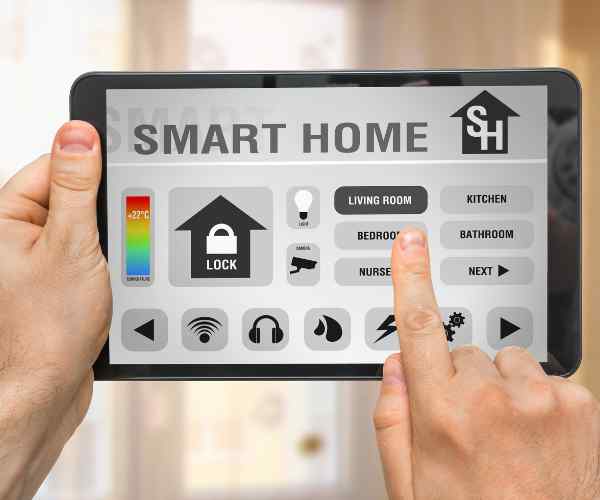When I first embarked on the journey of transforming my house into a smart home, I was thrilled at the thought of controlling lights, thermostats, and security cameras with just my voice or a simple app. The convenience was unparalleled. However, my excitement quickly turned into concern when I learned about a neighbor’s smart camera being hacked, providing unauthorized access to their private moments. This incident was a stark reminder of the vulnerabilities associated with these technological advancements.
The critical need for robust security measures became evident, not just for safeguarding my personal data but also for maintaining the integrity of my home network. This realization prompted me to delve deeper into the world of smart home security, uncovering risks, implementing both basic and advanced security tips, and seeking answers to common questions. This blog post is the culmination of my journey, aiming to shed light on the importance of securing smart home devices against ever-evolving cyber threats.

The Vulnerabilities of Smart Home Technology
Smart home devices, or IoT devices, bring a level of convenience into our lives that was unimaginable just a few decades ago. However, this convenience comes with its own set of vulnerabilities. A study by the University of Michigan and Microsoft uncovered that a significant number of smart home devices come with default passwords such as “admin” or “password,” making them easy targets for cyber-attacks. Furthermore, many of these devices connect to the internet via unsecured Wi-Fi networks, leaving an open door for hackers to exploit.
Credential stuffing, a cyber-attack method where attackers use stolen account credentials to gain unauthorized access to user accounts, poses a significant threat to smart home ecosystems. The same research indicated that potentially unwanted applications (PUAs) could infiltrate home networks, introducing malware or spyware that could compromise security systems or personal data.
Real-Life Consequences of Unsecured Devices
The consequences of unsecured smart home devices are not just theoretical. Personal stories and research incidents paint a grim picture. For instance, a family in Mississippi reported that a hacker spoke to their eight-year-old daughter through a smart camera in her bedroom. In another case, a couple’s home security system was breached, and the hacker remotely communicated with them through the system’s speaker, instilling fear and confusion.
These incidents are not isolated. According to a report by the cybersecurity firm Symantec, there has been a 600% increase in cyber attacks targeting IoT devices. These breaches can lead to identity theft, the loss of personal data, and unauthorized access to home security systems.
Essential Tips for Securing Your Smart Home Devices
Securing your smart home devices is not just about purchasing the latest gadgets with the most advanced security features. It involves proactive steps to ensure these devices and the networks they connect to are fortified against potential cyber threats. Here are essential tips to enhance the security of your smart home ecosystem.
Strong passwords and regular updates
The cornerstone of securing any digital device, especially smart home devices, lies in the strength of your passwords and the regularity of software updates. A study from the National Institute of Standards and Technology (NIST) emphasizes the significance of strong passwords in safeguarding digital accounts and devices against unauthorized access. Here’s how you can implement this:
- Create Unique, Strong Passwords: Every device in your smart home ecosystem should have a unique password that combines letters, numbers, and special characters. Avoid common phrases or easy-to-guess information like birthdays or anniversaries.
- Utilize a Password Manager: Managing a myriad of strong, unique passwords can be daunting. Cybersecurity experts recommend using reputable password managers to store and generate complex passwords, significantly reducing the risk of password-related breaches.
- Regular Software and Firmware Updates: Manufacturers frequently release updates for smart home devices to patch known vulnerabilities. An analysis by the University of Cambridge found that over 30% of IoT device vulnerabilities could be mitigated simply by updating the software. Set your devices to update automatically, or set regular reminders to check for updates manually.
Secure Your Wi-Fi Network
Your smart home devices are only as secure as the network they connect to. An unsecured Wi-Fi network is a prime target for hackers looking to access your devices. Follow these steps to bolster your home network security:
- Change the Default Router Password: The default password on many routers is often well-known or easy to guess. Changing this password to something complex and unique is a critical first step in securing your network.
- Enable WPA2 or WPA3 Encryption: Wi-Fi Protected Access 2 (WPA2) or the more recent WPA3 encryption should be enabled on your router. This encryption standard secures the data traveling between your router and connected devices, making it difficult for hackers to intercept.
- Use a Virtual Private Network (VPN): A VPN creates a secure tunnel for your internet traffic, encrypting data and hiding your IP address from potential snoops. Using a VPN on your router can add an extra layer of security, especially for smart home devices that don’t support VPN software directly.
- Create a Guest Network: Most modern routers allow you to create a separate network for guests. This feature can be used to isolate smart home devices from the main network that handles more sensitive data, reducing the risk of cross-device hacking.
Use two-factor authentication (2FA).
Two-Factor Authentication (2FA) has become the gold standard for enhancing online security across various platforms, and its importance extends to smart home devices and accounts. By requiring a second form of verification beyond just a password, 2FA significantly reduces the risk of unauthorized access, even if a hacker manages to decipher your password.
How 2FA works:
2FA adds an additional layer of security by combining something you know (like a password) with something you have (such as a code sent to your phone) or something you are (like a fingerprint). This dual-layer approach makes it exponentially harder for attackers to gain access to your devices.
Evidence of effectiveness:
A study conducted by Google in collaboration with New York University and the University of California, San Diego, found that text-based 2FA blocked 100% of automated bots, 96% of bulk phishing attacks, and 76% of targeted attacks. For smart home devices, where personal privacy and security are paramount, enabling 2FA wherever available is crucial.
Implementing 2FA on Smart Devices:
- Check device settings: Begin by exploring the settings of your smart home devices and accounts to identify those that offer 2FA.
- Use Authenticator Apps: Whenever possible, opt for authentication apps over SMS-based 2FA, as they provide security codes that are harder for attackers to intercept.
- Regularly Update Recovery Information: Ensure your recovery information is up-to-date to prevent being locked out of your accounts.
Disconnect Unused Devices
The concept of “attack surface reduction” is a key principle in cybersecurity, referring to minimizing the number of potential entry points for hackers into a system. In the context of smart homes, this means disconnecting or turning off smart devices that are not in regular use.
Rationale and Benefits:
Every connected device is a potential gateway for cybercriminals. By limiting the number of devices that are connected to the internet, you significantly reduce the risk of unauthorized access.
Practical Steps:
- Inventory Your Devices: Regularly review the devices connected to your home network. Identify those that are unnecessary or infrequently used.
- Disable Unnecessary Features: For devices that need to stay connected, disable any non-essential features that require internet access.
- Physically Disconnect Devices: When possible, physically disconnect or power down devices that are not in use.
Impact of Reduction:
The benefits of reducing your attack surface are supported by data from cybersecurity firms. For instance, Symantec’s Internet Security Threat Report highlighted that IoT devices were the target of over 5,200 attacks per month, illustrating the potential risk reduction by minimizing the number of connected devices.
More Post
Advanced Strategies for Smart Home Security
In the evolving landscape of smart home technology, basic security measures, while essential, may not suffice against sophisticated cyber threats. Advanced strategies are crucial for fortifying your smart home against potential risks. These strategies not only enhance security but also provide peace of mind knowing your digital fortress is well-guarded.
Implement a separate network for smart devices.
One of the most effective strategies recommended by cybersecurity experts is to set up a separate network for your smart home devices. This approach isolates your IoT devices from the main network that carries sensitive personal and financial information.
Why a separate network?
- Minimizes Cross-Device Attacks: By segregating your devices onto different networks, you reduce the risk of a compromised device affecting others or accessing sensitive data on your main network.
- Easier Monitoring: It’s simpler to monitor traffic and detect unusual activity on a dedicated IoT network, helping identify potential security breaches early.
Implementation Steps:
- Consult Your Router’s Documentation: Many modern routers support the creation of guest networks or multiple SSIDs (Service Set Identifiers), which can serve as a separate network for your IoT devices.
- Configure Network Settings: Assign your smart home devices to a separate network. Ensure it’s encrypted with WPA2 or WPA3 security protocols.
- Limit Access: Ensure the IoT network does not have access to the main network’s files and vice versa.
Real-World Impact:
In a survey conducted by a leading cybersecurity firm, over 30% of households reported using separate networks for their IoT devices, noting a significant decrease in security incidents.
Regular security audits
Conducting regular security audits of your smart home setup is akin to a health check-up for your home’s digital ecosystem. These audits help identify vulnerabilities before they can be exploited by cybercriminals.
Components of a DIY Security Audit:
- Check Device and Network Settings: Review the settings on each smart device and your network. Ensure the firmware is up-to-date and that unnecessary features are disabled.
- Update Passwords: Change default passwords and update them regularly. Consider using a password manager to generate and store complex passwords.
- Review device permissions: Pay special attention to devices with cameras or microphones, like smart cameras and speakers. Ensure they only have the permissions they need to function and nothing more.
Guiding Through an Audit:
- Create an inventory: list all connected devices and their current firmware version, password strength, and permissions.
- Assess and prioritize: identify which devices hold the most sensitive data or could be most damaging if compromised.
- Implement Changes: Based on your assessment, apply necessary updates, change passwords, and adjust settings.
Statistics and Studies:
A study by the University of Maryland found that the average smart home is subjected to potential threats every two seconds. This statistic underscores the importance of regular security audits for maintaining a secure smart home environment.
FAQs
How Can I Ensure My Smart Home Devices Are Secure?
Securing your smart home devices involves a multifaceted approach. Start with strong, unique passwords for each device and your Wi-Fi network. Enable two-factor authentication (2FA) where available, and regularly update your devices’ firmware and software to patch known vulnerabilities. Additionally, consider setting up a separate network for your IoT devices to isolate them from your main network and conducting regular security audits to identify and mitigate risks.
What are the best practices to protect against identity theft in a smart home environment?
To protect against identity theft, it’s crucial to secure your personal data. This includes using encrypted communication for your devices, ensuring that any personal information stored on devices is minimally necessary and properly secured, and being vigilant about phishing attempts that may target your smart home devices. Regularly monitoring your credit and using services like identity theft protection can also provide additional layers of security.
How Often Should I Update My Smart Home Device Settings?
Device settings and firmware should be updated as soon as updates are available. Many security breaches exploit known vulnerabilities, for which patches are already available. Setting your devices to automatically update when possible is a good practice, but for devices that require manual updates, consider setting a monthly reminder to check for updates.
Conclusion
The journey to securing smart home devices and networks against cyber threats is ongoing and requires constant vigilance. The convenience of smart home technology brings with it the responsibility to protect these digital extensions of our physical world. Remember, the goal is not just to secure devices against unauthorized access but to safeguard our personal privacy and data integrity.
It’s imperative for each of us to stay informed about the latest security trends and threats in the IoT and smart home technology spaces. Regularly reviewing your home’s security setup, updating device settings, and being proactive in your cybersecurity practices can make a significant difference in the overall security of your smart home.
More Post






